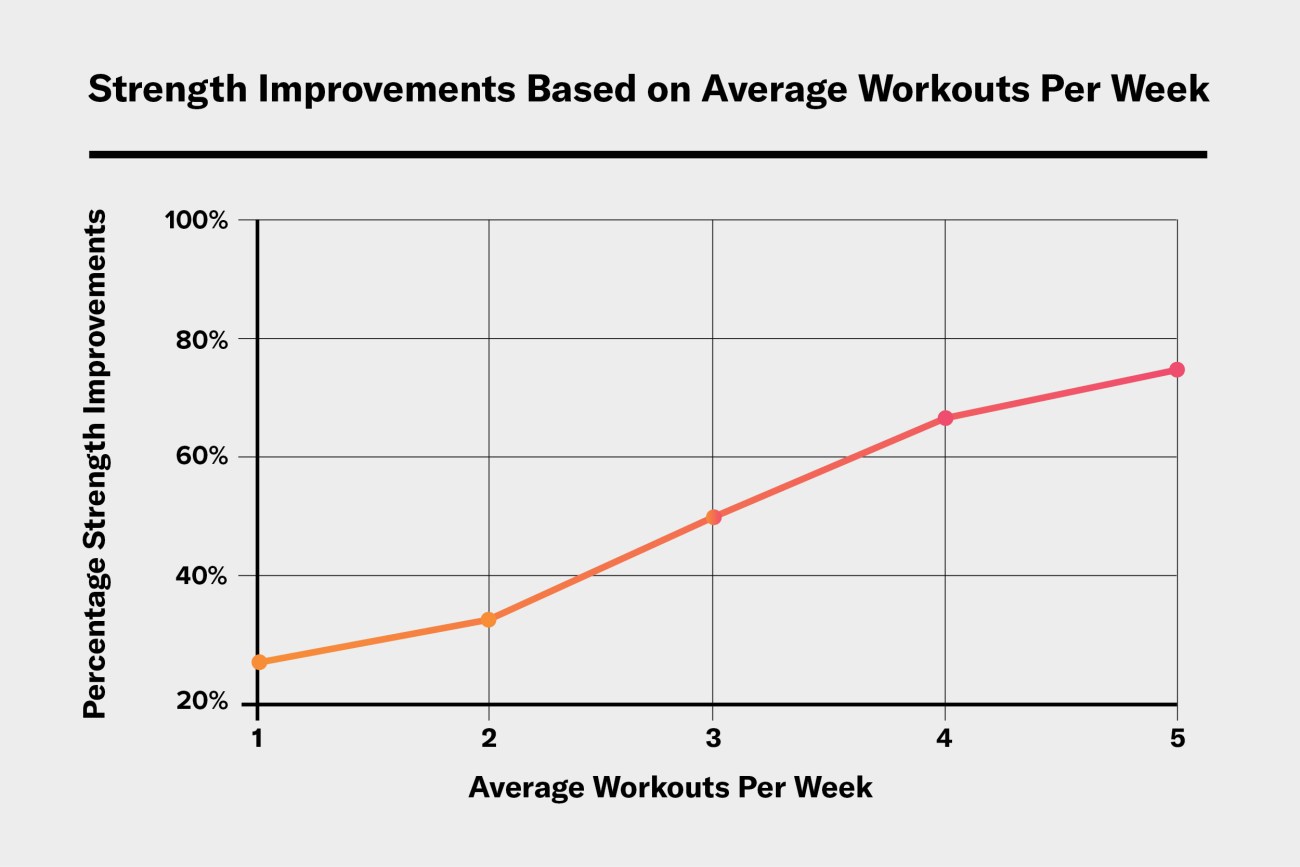The Tonal dataset reveals the most effective strategies to boost your gains.

New and experienced exercisers alike search for the secret to the most effective workout plan. While it differs from person to person, anonymous performance data from tens of thousands of Tonal users reveals a few key trends in workout habits that will help you build maximum strength. Here are the top five strategies you can apply to your own routine.

Workout frequency can be a key factor for future strength improvements. On average, when users added one more strength training session to their weekly routine for a year, they saw an improvement in overall strength by around 15 percent.
It makes sense: If your goal is to build strength, research shows a dose-response, meaning the more you do, the stronger you get when it comes to frequency. That’s because frequency can be considered a form of overload, additional stress to the muscles that occurs during that extra workout.
But this is only true to a point. Based on the data, the sweet spot is between two and five days per week to see the dose-response. If you aren’t in that range consistently, try to build up to it. The American College of Sports Medicine recommends completing two to three resistance training sessions per week. There is no need to max out your week with seven straight days of hard workouts or complete multiple workouts per day.
The chart below shows the average strength gains for a majority of Tonal members based on how many sessions per week they performed over the course of a year.

As the average number of workouts per week increases to five, the percent increase in strength jumps up another 15 percent. This doesn’t mean that you should go from one session per week to five the next; the goal is to progress gradually to avoid injury and burnout. If you’re currently doing anywhere from zero to four days of resistance training, adding one extra day to what you’re doing now is a surefire way to boost gains.

The data suggests there is a similar response to strength in regards to how long your workout lasts. In Tonal users who worked out two to three times per week, strength improved in slightly longer workouts, until you get to 55 minutes where it levels off.
Below is a graph showing percentage improvements in strength over a year when the duration of the workout is longer.

This shows you don’t need to slog away for hours. Remember: Even 20 minutes of training is better than zero minutes of training, but if you can push yourself for just 10 minutes more in your workout, you can get a huge return on your efforts in strength gains.

An essential step in building a habit is getting your workout in within a specific window of time that’s right for you. Research and Tonal’s performance data show consistency in your planning and execution of exercise can be the key to success.
Based on Tonal users, 31 percent of exercisers preferred to work out in the morning (before 10 a.m.); 36 percent preferred midday (10 a.m. to 4 p.m); and 33 percent in the evening (after 4 p.m.)—a pretty even split. The graph below shows the average frequency of workouts based on time of day.

The frequency of weekly workouts on average, shown by the white line, was fairly consistent across all windows of time. While early exercisers saw slightly higher frequencies, in the long run, staying consistent in your window is more important. The best workout is a completed one, so pick a window of time that works in your schedule and when you have the most energy and try to stick to it.

Training for strength is like training for a marathon, and if you were to lose momentum in a week of marathon training, you wouldn’t stop running altogether. If you miss strength training for one week or more, don’t worry. Flexibility in your goals can be key to building long-term strength. Research even shows that the more trained you are, the quicker you will gain back your strength after taking a break.
The data suggests that weekly consistency does not strongly impact overall strength gains as long as you get back to your routine. If you miss a few workouts or even a whole week, you haven’t lost all momentum. Doing your best to maintain a target of average weekly workouts will lead to more strength gains in the long run.

To get the most bang for your buck in strength performance, consider how you are using your workout time. The more time you are actually performing exercises within your workout instead of resting or setting up for the exercise could determine your strength gains over time.
The graph below shows Tonal users who worked out for an average of at least once a week and their ratio of minutes actually performing an exercise during a workout compared to the entire workout duration. The exercisers are divided into three groups based on how long they perform exercises during a 30-minute workout: low ratio (7.6 minutes), medium ratio (10.7 minutes), and high ratio (13 minutes).

The users who worked out for an average of 13 minutes out of the 30-minute workout had higher strength gains over time. This 13-minute threshold is supported by research indicating that just 13-minutes three times per week was a minimum dose needed to maintain strength gains.
Think quality and quantity during your workouts. Maintain your rest periods when warranted within the workout, but don’t take too long between exercises because you could be missing out on precious time toward your goals.